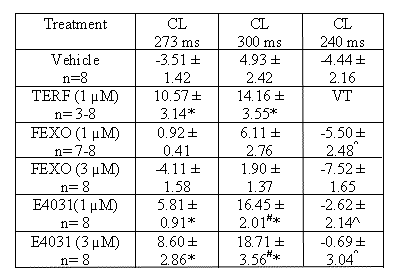| pA2
online © Copyright 2003 The British Pharmacological Society |
040P
University of Surrey Summer Meeting June 2003 |
|
The effect of terfenadine, fexofenadine and E4031 inisolated and perfussed guinea-pig hearts
M. Maginn, O. Åkerlund and J. Matz. Department of Safety Pharmacology. H. Lundbeck A/S. Copenhagen. Denmark. |
Print abstract Search PubMed for: |
Torsade de pointes
(TdP) is a rare form of polymorphic ventricular tachycardia (VT) that
exhibits a characteristic twisting of QRS complexes around the isoelectric
axis. TdP is preceded by a delay in ventricular repolarisation reflected
as an increase in the QT interval on the ECG. The mechanism of onset is
unknown but terfenadine (TERF) at above therapeutic concentrations prolong
QT intervals and are associated with TdP (Monahan et al., 1990).
The aim of this study was to compare the effects of TERF and its metabolite
fexofenadine (FEXO) in the guinea pig Langendorff heart model with E4031,
a potent antagonist for the Ikr repolarisation
current (Follmer and Colatsky, 1990) at various cycle lengths at relevant
therapeutic concentrations.
Male guinea-pigs were anaesthetised with sodium pentobarbital (250 mg/kg,
i.p.) the hearts were removed and perfused via the aorta with Krebs-Heinselett
solution. The hearts were paced at 273 ms CL. Following an equilibration
period and a 30 min infusion period of TERF (1.0 µM), FEXO and E4031
(1.0, 3.0 µM) the effects of the cycle length (CL) variation was
tested by changing the pacing frequency to a CL of 300 ms and then to
240 ms. Electrocardiograms were digitised and the QT-interval was measured.
Drug treatments were compared to the time matched vehicle group at 273
ms. The effect of CL variation was compared within each treatment group.
All data are presented as the mean percentage change from baseline ±
S.E.M.
The results are shown on Table 1.
Table 1: Effect of TERF, FEXO and E4031 on the QT interval (percentage
change from baseline) following a 30 min infusion at CL of 273 ms, 300
ms and 240 ms.

VT=ventricular
tachycardia. *p<0.05 (Student t-test, drug treatment
vs time matched vehicle group). #p<0.05
(Student t-test, drug treatment at 300 ms CL vs drug treatment at 273
ms CL). ^p<0.05 (Student t-test, drug treatment at 300 ms
CL vs drug treatment at 273 ms CL).
In conclusion, TERF and E4031 but not FEXO significantly prolonged the
QT interval following 30 min incubation at the normal CL. Variation in
CL in the TERF group caused increased conduction abnormalities leading
to VT. Although E4031 markedly delayed ventricular repolarisation no cardiac
arrhythmias were detected.
Monaghan BP., et al., (1990). JAMA 266 (17) 2375-2376.
Follmer CH. & Colatsky, TJ., (1990). Circulation 82,
289-293.